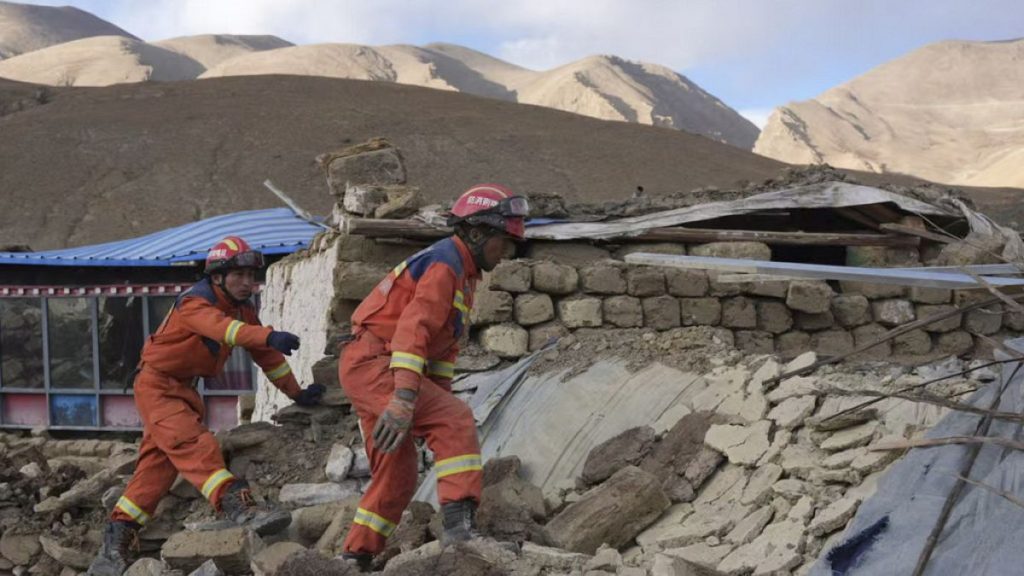The devastating 7.1-magnitude earthquake that struck Dingri County in Xigaze, Tibet, on Tuesday morning has resulted in a significant loss of life and widespread displacement. As of Wednesday, the death toll has climbed to 126, with 188 reported injuries, making this one of the deadliest earthquakes to hit China in recent years. Over 46,525 people have been evacuated from their homes and are now sheltering in 187 relocation sites set up across the county. Rescue teams are working tirelessly against the clock to locate and extract any survivors trapped beneath the rubble, facing immense challenges posed by the region’s harsh winter conditions and high altitude. Sub-zero temperatures, reaching as low as -18 degrees Celsius overnight, pose a severe threat to those still trapped and those who have been displaced.
The immediate priority for rescue workers and local officials is to ensure the survival of those affected by the earthquake. Rescue forces and essential supplies are continuously flowing into the quake-stricken areas. Local authorities have prioritized providing food, shelter, and cold-weather supplies to those in need, ensuring access to warm meals and adequate protection against the extreme cold. Officials report that all trapped individuals identified by Wednesday afternoon had been rescued and relocated to shelters, where they received hot meals and winter supplies. Early reports from the shelters indicate that the provided supplies were effective in maintaining a relatively warm environment overnight, mitigating the risk of hypothermia and frostbite.
The Chinese government has responded swiftly to the disaster, allocating substantial financial resources for relief efforts. The Ministry of Finance and the Ministry of Agriculture and Rural Affairs have jointly earmarked 80 million yuan (€10.6 million) in emergency funds to support farmers and livestock breeders in the affected region. This funding will be crucial in addressing immediate needs, such as providing food, shelter, and medical care, as well as supporting longer-term recovery efforts, including rebuilding homes and restoring agricultural livelihoods. The swift allocation of funds underscores the government’s commitment to assisting those impacted by this devastating natural disaster.
The earthquake’s epicenter lies within a geologically active zone where the Indian and Eurasian tectonic plates collide. This region, encompassing southwestern China, Nepal, and northern India, is prone to seismic activity. The collision of these massive plates creates immense pressure, leading to frequent earthquakes of varying magnitudes. This particular earthquake, with its significant magnitude of 7.1, highlights the inherent risks associated with this tectonic convergence. The ongoing collision and resulting seismic activity necessitates continuous monitoring and preparedness measures to mitigate the impact of future earthquakes in this vulnerable region.
The rescue operation in Dingri County continues to be a race against time and the elements. The combination of freezing temperatures, high altitude, and the potential for aftershocks creates a perilous environment for both survivors and rescuers. The immediate focus remains on locating and rescuing any remaining survivors, providing essential aid to those displaced, and ensuring their safety and well-being in the challenging conditions. The coordinated efforts of rescue teams, local authorities, and the central government are crucial in addressing the immediate crisis and laying the groundwork for the long and arduous process of recovery and reconstruction.
The aftermath of this earthquake will undoubtedly have long-lasting impacts on the region. Beyond the immediate loss of life and destruction of property, the earthquake will likely disrupt livelihoods, particularly for farmers and livestock breeders, and strain local infrastructure. The recovery and reconstruction process will require significant investment and coordination to rebuild homes, restore essential services, and support the affected communities in regaining their footing. The resilience of the Tibetan people, coupled with the ongoing support from the government and aid organizations, will be instrumental in overcoming the challenges ahead and rebuilding their lives in the wake of this tragedy.














